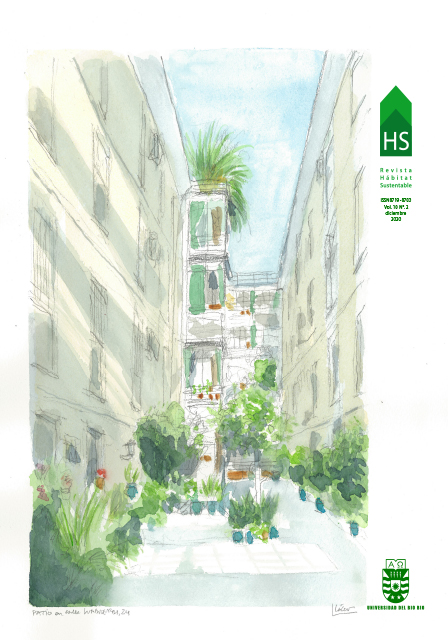Editorial
DOI:
https://doi.org/10.22320/07190700.2020.10.02.00Palabras clave:
-Resumen
Se me ha otorgado el gran honor de escribir este Editorial, precisamente para el presente volumen 10, segundo número del año 2020 de la Revista Hábitat Sustentable, cuando da inicio su segunda década de vida y pasa a formar parte del índice SCOPUS, logro muy relevante para una revista científica del ámbito académico chileno e iberoamericano, única en abordar temáticas específicas de la sustentabilidad en arquitectura y ambiente construido. Un gran motivo para sentir orgullo del competente trabajo que ha venido realizando hasta aquí el equipo editorial de HS de la Facultad de Arquitectura UBB involucrado en este proceso, donde indudablemente también juega un rol importantísimo la comunidad de autores/as, evaluadores/as y lectores/as que hace posible la sostenibilidad de la revista en el tiempo. Desde esta tribuna, entonces, y con esta una nueva motivación, los invitamos a continuar enviando sus trabajos a HS.
La Editora Responsable de HS, la Dra. Claudia Muñoz, iniciaba la edición pasada refiriendo a la pandemia causada por el coronavirus SARS-CoV-2 y escribía “en el día 104 de la cuarentena en Chile…”. Hoy enteramos aproximadamente 270 días de la llegada del virus a nuestro país, la incertidumbre continúa y a ella se suma el cansancio que todos hemos acumulado ante esta vivencia, la que en muchos casos ha sido extremadamente traumática. No puedo dejar de mencionarlo, dada la importancia y urgencia que cobra la investigación científica de excelencia en el mundo y el rol que, en consecuencia, juegan los investigadores y la divulgación de su trabajo a la hora de contribuir a nuestras sociedades y a nuestro planeta, para, en última instancia, salvar vidas e impactar postivamente en la calidad de vida de todas las especies que habitamos en la Tierra.
La generación de conocimiento a través de la investigación científica es la que aportará a la consecución de esa tan ansiada y necesaria libertad, que nos permitirá vivir sin miedo y en un hábitat más sustentable, sano, justo y digno para todas y todos. A la vez, en el ámbito académico resulta abrumador observar la ploriferación de estudios, reportes, análisis, prospectivas, encuestas, etc., acerca de lo que puede suponer el mundo, respecto de la fragilidad de nuestra existencia como especie humana y el vulnerable sistema de vida que hemos desarrollado como sociedad. Sin embargo, comenzar esta nueva década habiendo terminado la presente con la gran pandemia que estamos experimentando, impone hoy más que nunca el gran desafío de desarrollar el quehacer investigativo en asociatividad y colaboración entre actores del sector público, del productivo y del académico, ojalá más apegados a la realidad que vivimos.
Es así como, desde el enfoque editorial de HS, es primordial continuar generando aportes científico-tecnológicas hacia la sustentabilidad del ambiente construido, tales como las provenientes de Argentina, España y Chile, en los artículos aquí presentados, donde las fachadas verdes o las fachadas ventiladas se ven, una vez más, corroboradas como estrategias que contribuyen a mejorar la habitabilidad de los ocupantes; o donde se demuestra, de igual modo, que el ancestral y sostenible uso de la tierra en su versión de ‘bloque de tierra’ continúa siendo un material de construcción vigente, tecnológicamente mejorable y digno de innovar a partir de sus cualidades. A ellos se suman la revisión y reflexión sobre lo que se viene, “Zero Energy Buildings”, y sobre la transición energética requerida para adaptarnos a los cambios climáticos y sociales que palpamos cotidianamente, cuando es tan oportuno volver a revisar temas como la prefabricación del pasado, para ayudarnos a mirar hacia el futuro.
Desde ese horizonte, finalmente, doy las gracias a este tremendo equipo editorial de HS, a cada uno de ellos sin excepción.
Descargas
Citas
-
Descargas
Publicado
Cómo citar
Número
Sección
Licencia
Derechos de autor 2020 Nina Amor Hormazábal-Poblete

Esta obra está bajo una licencia internacional Creative Commons Atribución-CompartirIgual 4.0.
El contenido de los artículos que se publican en cada número de Hábitat Sustentable, es responsabilidad exclusiva de los autores y no representan necesariamente el pensamiento ni comprometen la opinión de la Universidad del Bío-Bío.
Los autores/as conservarán sus derechos de autor y garantizarán a la revista el derecho de primera publicación de su obra, el cuál estará simultáneamente sujeto a la Licencia de Reconocimiento de Creative Commons CC BY-SA que permite a otros compartir-copiar, transformar o crear nuevo material a partir de esta obra con fines no comerciales, siempre y cuando se reconozcan la autoría y la primera publicación en esta revista, y sus nuevas creaciones estén bajo una licencia con los mismos términos.











 Programa de Información Científica/Concurso Fondos de Publicación de Revistas Científicas 2018/ Proyecto Mejoramiento de Visibilidad de Revistas UBB (Código:FP180007)
Programa de Información Científica/Concurso Fondos de Publicación de Revistas Científicas 2018/ Proyecto Mejoramiento de Visibilidad de Revistas UBB (Código:FP180007) 





